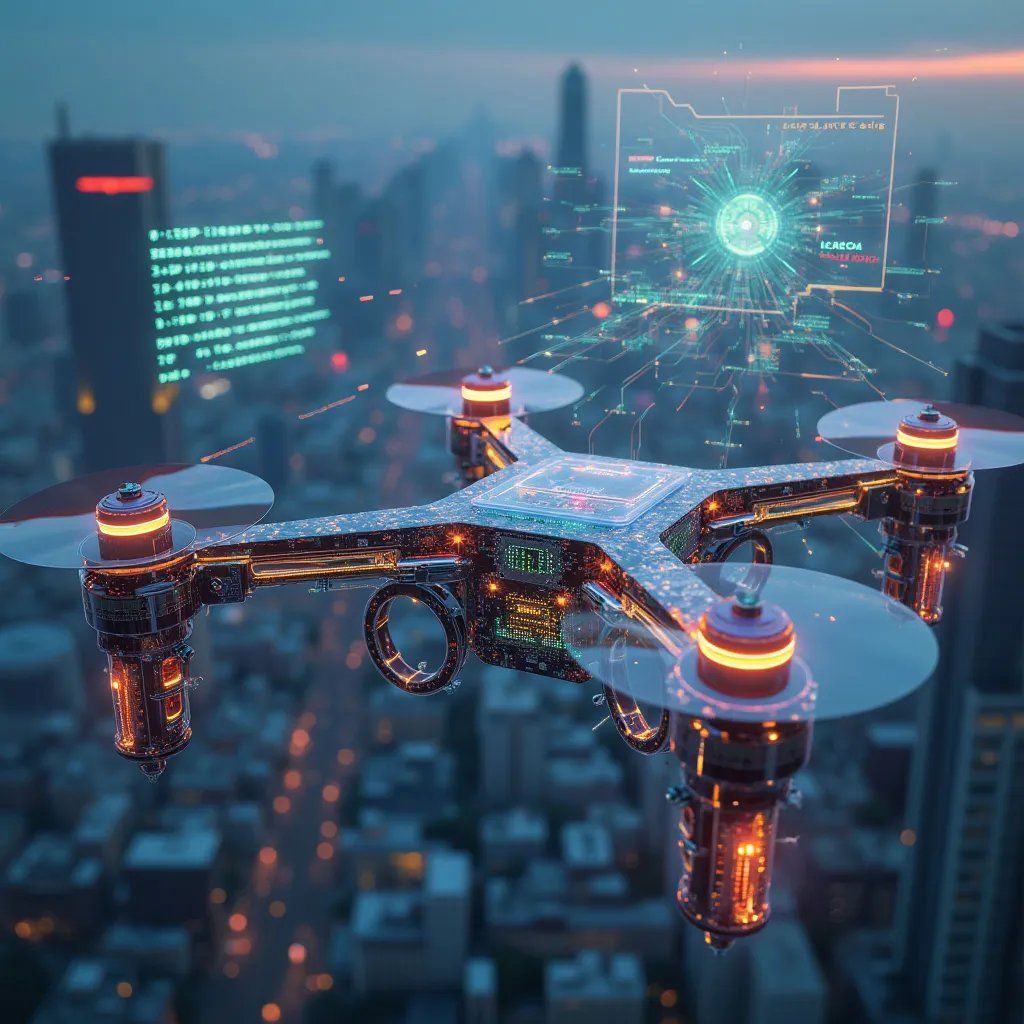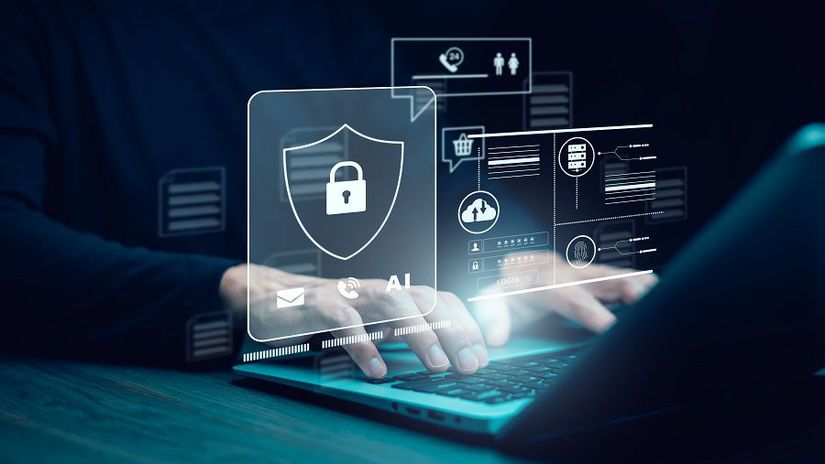Úvod
Kvantové útoky v prevádzke bezpilotných lietadiel predstavujú novú paradigmu hrozieb, ktorá využíva možnosti kvantovej výpočtovej techniky na narušenie súčasných šifrovacích metód používaných v komunikácii a systémoch bezpilotných lietadiel. Táto pokročilá forma kybernetickej hrozby má potenciál zásadne zmeniť prostredie bezpečnosti dronov a vyžaduje si inovatívne prístupy na ochranu pred budúcimi kvantovými počítačovými schopnosťami.
Krajina hrozieb
Dôsledky kvantovej výpočtovej techniky v oblasti kybernetickej bezpečnosti ďaleko presahujú rámec bežných hrozieb a môžu narušiť základné bezpečnostné mechanizmy súčasných bezpilotných systémov. S rozvojom kvantových počítačov majú schopnosť prelomiť mnohé súčasné šifrovacie metódy, čo do prevádzky dronov prináša bezprecedentné zraniteľnosti. Tento vývoj výpočtovej sily hrozí, že súčasné bezpečnostné opatrenia sa stanú zastaranými, čo si vyžiada zásadnú zmenu v prístupe k bezpečnosti dronov.
import hashlib
tajomstvá dovozu
z adresy dataclasses import dataclass
from typing import List, Optional, Tuple
čas dovozu
z adresy enum import Enum
import logging
import numpy ako np
# Konfigurácia protokolovania
logging.basicConfig(level=logging.INFO)
logger = logging.getLogger(__name__)
trieda SecurityLevel(Enum):
CLASSICAL = 1
HYBRID = 2
POST_QUANTUM = 3
@dataclass
trieda QuantumResistantKey:
"""Predstavuje kvantovo odolný kryptografický kľúč"""
public_key: bajty
private_key: bajty
creation_time: float
expiry_time: float
security_level: SecurityLevel
trieda PostQuantumCrypto:
"""Simulovaný post-kvantový kryptografický systém"""
def __init__(self, security_level: SecurityLevel = SecurityLevel.POST_QUANTUM):
self.security_level = security_level
self.key_size = self._determine_key_size()
self.active_keys: Zoznam[QuantumResistantKey] = []
def _determine_key_size(self) -> int:
"""Určiť vhodnú veľkosť kľúča na základe úrovne zabezpečenia"""
ak self.security_level == SecurityLevel.CLASSICAL:
vrátiť 256 # Klasická úroveň zabezpečenia
elif self.security_level == SecurityLevel.HYBRID:
vrátiť 384 # Hybridná klasicko-kvantová bezpečnosť
inak:
vrátiť 512 # Úroveň zabezpečenia po kvantovaní
def generate_quantum_resistant_key(self) -> QuantumResistantKey:
"""Vygenerujte pár kľúčov odolných voči kvantovaniu"""
# V reálnej implementácii použite zavedené post-kvantové algoritmy
# Toto je zjednodušený príklad na demonštráciu
private_key = secrets.token_bytes(self.key_size)
public_key = hashlib.shake_256(private_key).digest(self.key_size)
kľúč = QuantumResistantKey(
public_key=public_key,
private_key=private_key,
creation_time=time.time(),
expiry_time=time.time() + 86400, # 24-hodinová platnosť
security_level=self.security_level
)
self.active_keys.append(kľúč)
návratový kľúč
def quantum_resistant_encrypt(self, data: bytes, key: KvantumResistantKey) -> bytes:
"""Šifrovanie údajov pomocou kvantovo odolného šifrovania"""
# Zjednodušené šifrovanie na ukážku
# V praxi používajte zavedené post-kvantové šifrovacie algoritmy
ak time.time() > key.expiry_time:
zvýšiť ValueError("Platnosť kľúča vypršala")
encryption_key = hashlib.shake_256(key.public_key).digest(len(data))
vrátiť bytes(a ^ b pre a, b v zip(data, encryption_key))
def quantum_resistant_dešifrovať(self, encrypted_data: bytes, key: QuantumResistantKey) -> bytes:
"""Dešifrovanie údajov pomocou kvantovo odolného šifrovania"""
# Zjednodušené dešifrovanie na ukážku
ak time.time() > key.expiry_time:
zvýšiť ValueError("Platnosť kľúča vypršala")
decryption_key = hashlib.shake_256(key.private_key).digest(len(encrypted_data))
vrátiť bytes(a ^ b pre a, b v zip(encrypted_data, dešifrovací_kľúč))
trieda QuantumResistantDrone:
"""Kvantový bezpečnostný systém odolný voči dronom"""
def __init__(self):
self.crypto = PostQuantumCrypto(SecurityLevel.POST_QUANTUM)
self.current_key: Voliteľné[QuantumResistantKey] = None
self.secure_channel_established = False
def establish_secure_channel(self) -> bool:
"""Vytvoriť kvantovo odolný bezpečný komunikačný kanál"""
vyskúšať:
self.current_key = self.crypto.generate_quantum_resistant_key()
self.secure_channel_established = True
logger.info("Vytvorený zabezpečený kvantovo-odolný kanál")
vrátiť True
okrem výnimky ako e:
logger.error(f”Failed to establish secure channel: {e}”)
vrátiť False
def send_secure_príkaz(self, command: str) -> Optional[bytes]:
"""Odoslať príkaz pomocou kvantovo odolného šifrovania"""
ak nie self.secure_channel_established alebo nie self.current_key:
logger.error("Zabezpečený kanál nebol vytvorený")
vrátiť None
vyskúšať:
command_bytes = command.encode()
encrypted_command = self.crypto.quantum_resistant_encrypt(
command_bytes, self.current_key
)
logger.info("Príkaz zašifrovaný pomocou kvantovo odolného šifrovania")
vrátiť encrypted_command
okrem výnimky ako e:
logger.error(f”Failed to send secure command: {e}”)
vrátiť None
def receive_secure_príkaz(self, encrypted_command: bytes) -> Optional[str]:
"""Prijať a dešifrovať príkaz pomocou kvantovo odolného šifrovania"""
ak nie self.secure_channel_established alebo nie self.current_key:
logger.error("Zabezpečený kanál nebol vytvorený")
vrátiť None
vyskúšať:
decrypted_bytes = self.crypto.quantum_resistant_decrypt(
encrypted_command, self.current_key
)
príkaz = decrypted_bytes.decode()
logger.info("Príkaz bol úspešne dešifrovaný")
príkaz na vrátenie
okrem výnimky ako e:
logger.error(f”Failed to decrypt command: {e}”)
vrátiť None
def demonštrácia_kvantovej_odolnosti_systém():
"""Demonštrácia kvantovo odolného bezpečnostného systému pre drony"""
# Inicializácia systému dronov
dron = QuantumResistantDrone()
# Zriadenie zabezpečeného kanála
vytlačiť("\nZaloženie bezpečného kvantovo odolného kanála...")
ak drone.establish_secure_channel():
# Odoslanie zabezpečeného príkazu
command = "NAVIGATE 47.6062° N, 122.3321° W"
print(f”\nSending command: {command}”)
encrypted_command = drone.send_secure_command(príkaz)
ak encrypted_command:
vytlačiť("Príkaz bol úspešne zašifrovaný")
# Príjem a dešifrovanie príkazu
decrypted_command = drone.receive_secure_command(encrypted_command)
ak decrypted_command:
print(f”Received and decrypted command: {decrypted_command}”)
# Overenie integrity príkazu
ak decrypted_command == príkaz:
vytlačiť("Integrita príkazu overená")
inak:
vytlačiť("Kontrola integrity príkazu zlyhala")
inak:
vytlačiť("Nepodarilo sa vytvoriť zabezpečený kanál")
if __name__ == "__main__":
demonštrácia_kvantovej_odolnostisystém()
Posúdenie zraniteľnosti
Kvantové hrozby zahŕňajú viacero kritických oblastí v rámci operácií s dronmi. Bezpečné komunikačné kanály, ktoré sú v súčasnosti chránené klasickými šifrovacími metódami, čelia potenciálnemu ohrozeniu zo strany kvantových výpočtových schopností. Autentifikačné protokoly a systémy distribúcie kľúčov, ktoré sú základom bezpečnej prevádzky dronov, sa môžu stať zraniteľnými voči kvantovým útokom. Okrem toho bezpečnosť uložených údajov čelí dlhodobým rizikám, keďže kvantové počítače sa zdokonaľujú.
Kvantovo odolný bezpečnostný systém Drone
Stratégie odolné voči kvantovým hrozbám Ochrana pred kvantovými hrozbami si vyžaduje implementáciu sofistikovaných bezpečnostných opatrení odolných voči kvantovým hrozbám. Postkvantová kryptografia (PQC) poskytuje matematické algoritmy navrhnuté tak, aby odolávali útokom kvantových počítačov. Kvantová distribúcia kľúčov (QKD) umožňuje bezpečnú komunikáciu prostredníctvom kvantovo mechanických princípov, zatiaľ čo hybridné klasicko-kvantové šifrovacie schémy ponúkajú prechodné bezpečnostné riešenia. Tieto opatrenia dopĺňajú kvantovo odolné autentifikačné metódy, ktoré zabezpečujú bezpečnú kontrolu prístupu v kvantovej ére.
Prevádzkové výhody
Zavedenie kvantovo bezpečných opatrení poskytuje zásadné výhody pre prevádzku dronov. Tento prístup zabezpečuje bezpečnosť dronov pred vznikajúcimi kvantovými hrozbami a zároveň zachováva dlhodobú dôvernosť údajov. Organizácie získavajú konkurenčnú výhodu vďaka rozšíreným bezpečnostným možnostiam, ktoré zabezpečujú prevádzkovú integritu v súvislosti s rozvojom kvantovej výpočtovej techniky.
Výzvy pri implementácii
Prechod na kvantovo bezpečnú bezpečnosť predstavuje niekoľko technických výziev. Kvantovo bezpečné algoritmy často vyžadujú značné výpočtové zdroje, čo môže mať vplyv na výkonnosť dronov. Integrácia s existujúcimi systémami dronov si vyžaduje starostlivé plánovanie a realizáciu, zatiaľ čo prebiehajúca štandardizácia postkvantových protokolov vytvára neistotu pri výbere implementácie. Organizácie musia starostlivo vyvážiť zvýšenú bezpečnosť s požiadavkami na prevádzkový výkon.
Úvahy o budúcnosti
Organizácie musia podniknúť proaktívne kroky, aby sa pripravili na éru kvantovej výpočtovej techniky. To zahŕňa komplexné posúdenie kvantových zraniteľností vo flotilách dronov, preskúmanie a implementáciu vhodných riešení postkvantovej kryptografie a aktívnu účasť na kvantovo bezpečných štandardizačných snahách s cieľom zabezpečiť súlad s novými priemyselnými štandardmi.
Technická podpora
Podrobné pokyny k implementácii a technickú dokumentáciu vám poskytne náš tím pre kvantové zabezpečenie na adrese [email protected]. Naši odborníci vám pomôžu s vývojom prispôsobených riešení kvantovo odolného zabezpečenia, ktoré spĺňajú vaše špecifické prevádzkové požiadavky.
Výsledok vykonania:
Vytvorenie bezpečného kvantovo odolného kanála...
Príkaz bol úspešne zašifrovaný
Prijatý a dešifrovaný príkaz: 47.6062° N, 122.3321° W
Overenie integrity príkazu







